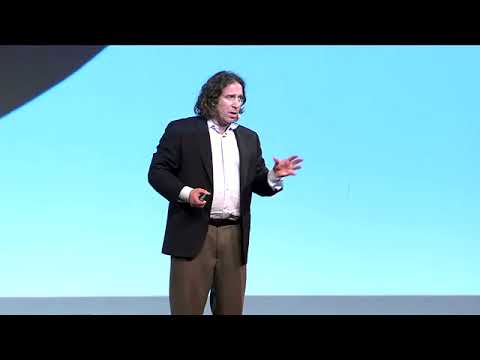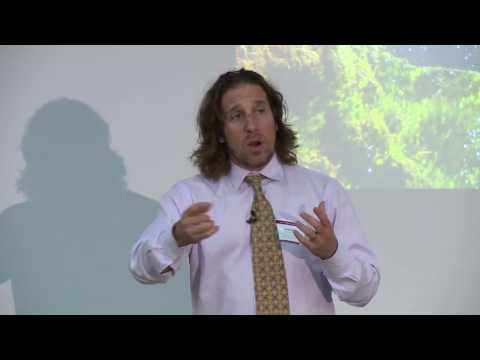Videos
Learn More About Jeremy Bailenson
We are living through the virtual revolution. Right under our noses, the steady evolution of virtual and augmented media is upending the ways we work, learn and communicate.
Jeremy Bailenson, Department of Communication Professor at Stanford University and founding director of its pioneering Virtual Human Interaction Lab (VHIL), is the foremost expert in VR and AR. The faculty director of Stanford’s Digital Learning Forum and the faculty leader of its Center for Longevity, Bailenson has deeply influenced today’s interactive media theorists and practitioners, as well as business leaders seeking to better understand technology, productivity and the future of work.
With the recent introduction of the “metaverse” to our lexicon, it’s no surprise that since 2003 Bailenson has been helping companies – including Samsung, HP and Apple – develop the underlying technology that fuels the metaverse, as well as teaching and building on his “Virtual People” course. In November 2021, his class went completely virtual – among the first in the world to offer such an experience – allowing students to learn and engage in an immersive virtual classroom.
“Our class IS the metaverse,” says Bailenson. “Nobody has tried to network 100 plus students via VR headsets for months at a time in the history of virtual reality, or even in the history of teaching. It’s VR at an incredible scale. It is the perfect example of how to build the infrastructure – hardware, software, content and people – and to build a persistent virtual world of avatars and scenes that people actually use.”
As the co-founder of STRIVR, a VR-based immersive learning platform provider, Bailenson works with numerous Fortune 500 companies and professional sports teams to reinvent learning and training through VR experiences. His seminal book on VR psychology, “Infinite Reality,” has influenced corporate strategy, national security and even the Supreme Court.
“Over the past few years, the cost to deploy VR has plummeted and the technology has expanded into more general use,” says Bailenson. “While VR was beginning to catch on before COVID-19, the push to remote work is fast-tracking the need for such tools.”
Bailenson’s latest book, “Experience on Demand: What Virtual Reality Is, How It Works, and What It Can Do” (Norton, 2018), expands upon his previous research to demonstrate how VR can revolutionize company practices across industries such as health care, sports and manufacturing. His most recent academic work focuses on VR as a tool to recruit, train and acculturate employees, instill values, reduce workforce fatigue and help solve climate change.
A gifted and highly in-demand speaker, Bailenson incorporates live VR demonstrations into his presentations, allowing audiences to experience the technology directly, rather than abstractly. With more than two decades of VR research produced under his management, he shares trends and analysis from VHIL’s extensive data sets — recognized as the best in the academic world for VR and AR.
By pulling back the curtain on today’s cutting-edge technologies, Bailenson helps audiences understand how to navigate the VR and AR landscapes and bring about overdue changes to traditional education.
“We are now seeing radical shifts occur in industries as diverse as retail, logistics and customer service because of immersive technologies,” says Bailenson. “VR and AR are the perfect media for this moment.”
###
Jeremy Bailenson serves on the scientific advisory boards of numerous companies, including Samsung, HP, High Fidelity, Mursion and Speech Graphics. In the public sector, he advises the Department of Defense, the U.S. Army, the National Resource Council and the National Institutes of Health. His research has been used by companies such as Facebook, the NFL and Microsoft, and has been documented in nearly 100 academic papers across the fields of communication, computer science, education, law, political science and psychology.
A senior fellow at the Woods Institute for the Environment, Bailenson’s work has been funded by the National Science Foundation for more than a decade. His previous teaching roles include working as an assistant research professor at the Research Center for Virtual Environments and Behavior at the University of California, Santa Barbara. He earned a Bachelor of Arts cum laude from the University of Michigan and a doctorate in cognitive psychology from Northwestern University.
Jeremy Bailenson is available to advise your organization via virtual and in-person consulting meetings, interactive workshops and customized keynotes through the exclusive representation of Stern Speakers & Advisors, a division of Stern Strategy Group®.
How Metaverse Technologies Will Transform Learning, Training and Operations
The metaverse may be a new concept for some people, but not for Jeremy Bailenson, Stanford Professor and founding director of the school’s Virtual Human Interaction Lab (VHIL). Since 2003, he has been helping companies, including Samsung, HP and Apple, develop the underlying technology that fuels the metaverse, as well as teaching and building on his “Virtual People” course. In November 2021, his class went completely virtual – among the first in the world to offer such an experience – allowing students to learn and engage in an immersive virtual classroom. In this talk, Professor Bailenson explains how the technologies and tools VHIL continues to develop are transforming the way companies and schools teach, train and operate, how they build culture, and how they communicate in an environment that offers countless opportunities for experimentation and innovation. “Our class IS the metaverse,” says Bailenson. “Nobody has tried to network 100 plus students via VR headsets for months at a time in the history of virtual reality, or even in the history of teaching. It’s VR at an incredible scale. It is the perfect example of how to build the infrastructure – hardware, software, content and people – and to build a persistent virtual world of avatars and scenes that people actually use.”
The Brave New World of Virtual Work
If people at your organization are suffering from zoom fatigue, it may be time to have Stanford cognitive scientist Jeremy Bailenson give them a preview of better things to come. Bailenson, who runs the Virtual Human Interaction Lab at Stanford University, is the world’s leading expert on virtual reality (VR), augmented reality (AR) and related fields. His work with companies in almost every sector, from startups to large technology firms, keeps him at the forefront of the latest technology and products as well as new developments on the horizon.
Acknowledging, like many, that remote work will soon become an established part of our lives, Bailenson introduces audiences to virtual alternatives that are poised to make WFH feel more natural, bearable and manageable. He shows participants how the emerging technologies – VR, avatars and AR – will become commonly used to enhance the virtual experience and advises business professionals on how to set up, execute and manage a collaborative virtual workspace. His keynotes and workshops also provide insights into where these technologies are going, how much they can adapt to us, and what types of behaviors can be expected from people who interact with them. As a dynamic speaker and a leading expert in the field, Bailenson is uniquely positioned to give employees at all levels of your organization the information and tools they’ll need to better navigate the new virtual work landscape going forward.
Using Virtual Reality to Strengthen Company Culture
As people become more disconnected due to remote work and distributed teams, how do we preserve company culture? More importantly, as the virtual office becomes mainstream, how can we sustain productive virtual work environments? In this talk, Stanford University Virtual Human Interaction Lab founding director Jeremy Bailenson provides a broad overview of how the workplace is changing and how VR can help bring continuity. Using selected case studies, he demonstrates how immersive technologies helped employees at Walmart reduce the length of training from eight hours to 15 minutes, employees at Verizon successfully de-escalate tense customer conversations in much less time and employees at Sprouts Farmers Market understand the company’s core values at a rate of 48% versus only 3% with PowerPoint. With Bailenson at the helm, this interactive and engaging presentation will teach the basics of non-verbal communication and media psychology through VR to help audiences improve soft skills and better understand the management tools at their disposal.
How VR Builds Empathy in Life and Business
Given recent high-profile exposés of racism and sexual harassment, it is critical for organizations to educate employees at all levels about diversity, tolerance and empathy. By allowing people to experience life as people of different races or genders – along with all the hardships and injustices they face – VR is a uniquely impactful educational tool. One can walk a mile in the shoes of another, and – by taking this novel perspective – empathize in a way that can change attitudes. Dozens of academic experiments have shown that intense VR experiences change beliefs and behavior more than movies or role-playing exercises. In this presentation, VR expert Jeremy Bailenson discusses his research findings which have resulted in a set of best practices for using VR for empathy. With illustrative case studies from corporations using VR at scale, Bailenson reveals the technology’s ability to improve employee performance and sharpen communication skills in difficult situations and interpersonal interactions. While no technology will miraculously eliminate bias, virtual experiences can help people improve how they treat each other.
VR as the Ultimate Corporate Training Machine
While virtual and augmented reality (VR/AR) have been around for decades in university laboratories and military facilities, for the first time in history there are millions of affordable systems in the hands of businesses and consumers. The AR/VR market is projected to take off over the next five years with a compound average growth rate of over 75%, growing to over $120 billion by 2022. Leading companies are already deploying the technology to instruct workers – a million Walmart employees will be trained using VR in 2019 alone. In this presentation, Jeremy Bailenson maps out VR/AR’s huge potential for making companies smarter and better prepared for a multitude of tasks. He illustrates how training and virtual experiences have reduced instruction time and boosted learning capacity. For example, hundreds of studies have demonstrated the efficacy of VR/AR surgery training, and thousands of surgeries each year are performed by doctors who are either remotely located and use networked VR/AR to perform the surgery or who are in the room with the patient but use the technology to augment their vision. How can VR have the same transformative impact on your industry? And how can your company harness the enormous opportunities of this emerging technology?
Experience on Demand: What Virtual Reality Is, How It Works and What It Can Do
Even though virtual reality (VR) has been around for decades, most consider 2014 as the beginning of the consumer revolution of VR. Professor Jeremy Bailenson, a pioneer in the technology behind VR, observed a lot of early optimism that year, with billions of dollars flowing into the industry with the prediction that VR would shortly be in every living room. To the surprise of many, that hasn’t happened, and instead, there are only a handful of early commercial success cases. Most VR applications are still in the novelty phase, or what some forecasters call the “trough of disillusionment.”
For adventurous audiences looking to better understand VR and the opportunities and challenges it presents for their businesses, this talk, based on Bailenson’s new book “Experience on Demand” (January 2018), will focus on practical applications of VR, such as training, healing, and communication, as well as the early VR industry winners and the factors that enabled their success. Through vivid case studies of companies using VR in their business strategy today – such as Walmart which trained a million employees with VR in 2019, the NFL which is using VR to train players, referees and executives to do media interviews, and Fidelity which is using VR to increase empathy between call center employees and customers – Bailenson reveals how, when coupled with his strategic implementation blueprint, VR can significantly contribute to an organization’s bottom line, solve organizational and customer problems and distinguish a brand as an innovative industry leader.
Opportunities and Challenges of Augmented Reality
Over the last few years, while the world was learning about the uses and hype around virtual reality, VR pioneer Jeremy Bailenson shifted much of his work into the augmented reality (AR) domain. AR – which overlays digital images on top of what we see in the real world so that digital information appears to be integrated with the physical world – has been around for decades. But due to some recent large investments and a flurry of press, AR has become an incredibly hot tech trend. Yet, while everyone is talking about it, very few people have experienced “high end” AR in which the digital world is effortlessly assimilated into the physical one.
Unlike VR, which has received a lot of attention from a wide range of academics for almost three decades, AR research – in particular research about the use cases and implications of AR use – is in its infancy. At the forefront of the technology, Bailenson’s research lab at Stanford studies the perceptual, social, and cognitive issues behind AR. He advises a number of major technology and AR-specific companies, such as Samsung, Avegant, and Eyeway Vision, on developing viable technology strategies that fit their business models. In this talk, he explains AR technology, highlighting the opportunities it presents as well as some of its constraints. Participants come away with a better understanding of how to think more strategically when creating and building products in the AR space.
The In-Goggle Experience
Theory is important, but nothing beats experience. In this workshop, conducted by Stanford’s Professor Jeremy Bailenson, attendees enter the world of virtual reality directly through the use of personal VR headsets, purchased in advance. Equal parts educational presentation and firsthand training, this program includes both group discussion sections via Zoom and unique, real-time content integrated experiences. Whether going to the moon or walking the floor at Walmart, audiences will be able to navigate VR through thematic adventures that reveal its most exciting and cutting-edge applications.

Experience on Demand: What Virtual Reality Is, How It Works, and What It Can Do
(W. W. Norton & Company, January 2018)

Infinite Reality: Avatars, Eternal Life, New Worlds, and the Dawn of the Virtual Revolution
(William Morrow, April 2011)

Lessons For/In Virtual Classrooms: Designing a Model for Classrooms Inside Virtual Reality
(Taylor & Francis, March 2024)

A Novel Quantitative Assessment of Engagement in Virtual Reality: Task-Unrelated Thought Is Reduced Compared to 2D Videos
(Computers & Education, November 2023)

Linguistic Markers of Inherently False AI Communication and Intentionally False Human Communication: Evidence From Hotel Reviews
(Journal of Language and Social Psychology, September 2023)

People, Places, And Time: A Large-Scale, Longitudinal Study Of Transformed Avatars And Environmental Context In Group Interaction In The Metaverse
(Journal of Computer-Mediated Communication, December 2022)

Prerequisites for Learning in Networked Immersive Virtual Reality
(Technology, Mind, and Behavior, Winter 2022)

Unintended Consequences of Spatial Presence on Learning in Virtual Reality
(Computers & Education, September 2022)

Understanding Group Behavior in Virtual Reality: A Large-Scale, Longitudinal Study in the Metaverse
(72nd Annual International Communication Association Conference, May 2022)

Key Considerations for Incorporating Conversational AI in Psychotherapy
(Frontiers in Psychiatry, October 2019)

The Effects of Virtual Human's Spatial and Behavioral Coherence with Physical Objects on Social Presence in AR
(Computer Animation and Virtual Worlds, March 2017)
Ask us about Jeremy Bailenson’s hands-on experiences that take learning beyond the boardroom.
The In-Goggle Experience
Theory is important, but nothing beats experience. In this workshop, conducted by Stanford’s Professor Jeremy Bailenson, attendees enter the world of virtual reality directly through the use of personal VR headsets, purchased in advance. Equal parts educational presentation and firsthand training, this program includes both group discussion sections via Zoom and unique, real-time content integrated experiences. Whether going to the moon or walking the floor at Walmart, audiences will be able to navigate VR through thematic adventures that reveal its most exciting and cutting-edge applications.
“Few people alive know as much about VR as Jeremy Bailenson. For decades he’s been researching how VR affects humans. Read this before you enter this new world.”
“Virtual reality is changing the way athletes train. This book is a must-read for anyone who wants to understand and hone performance through VR.”
“Jeremy Bailenson’s work is unflinching and brave. He helps us see more of our vulnerabilities and our potential than ever before. This book describes the edge of human self-knowledge, and a precipice of human foibles to avoid.”
“Bailenson provides a clarifying framework for a necessary conversation about what it will mean to ‘be there’ in the twenty-first century. Read this to calibrate the ethical and moral choices ahead.”
“As one of VR’s pioneers, Jeremy Bailenson sheds light on how it works, its benefits, and how it will impact us in the future.”
“Jeremy did very well and met our expectations. I have to say that our expectations were very high. He was an absolute success and the big talk of the day. Full match.”
“Jeremy’s presentation was great and exceeded our expectations. Our objective of presenting cutting-edge research was certainly met.”
“Jeremy Bailenson is a wonderfully engaging visionary whose passion for his cutting-edge scientific research is contagious! His insights into the power and possibilities of virtual environments will change the way you and your leaders look at the world. Jeremy brings an “A” game, and my company’s leaders find him to be an invaluable resource.”







































































